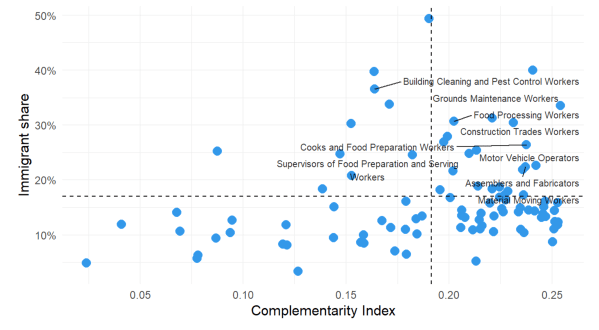Germany's Stricter Border Controls: Lowest Migration Since COVID-19

Table of Contents
The Role of Stricter Border Controls
The significant reduction in migration to Germany is directly linked to the government's intensified efforts to strengthen its border security and control immigration flows. This involves a multi-pronged approach encompassing technological advancements, policy adjustments, and enhanced international cooperation.
Increased Surveillance and Security
Germany has invested heavily in upgrading its border security infrastructure and employing advanced technologies to monitor and control entry points.
- Biometric scanning: Widespread implementation of biometric scanners at airports and major land border crossings allows for faster processing and improved identification of individuals.
- Improved data sharing: Enhanced data exchange with neighboring EU countries facilitates better tracking of individuals and identification of potential security risks. This cross-border collaboration is crucial in combating illegal immigration.
- Increased police presence: A visible increase in police and border patrol personnel at airports, train stations, and land borders serves as a deterrent to illegal crossings and facilitates more thorough checks.
- Advanced surveillance technologies: Deployment of advanced surveillance technologies, including CCTV cameras and drone patrols, enhances monitoring capabilities along Germany's borders.
Changes in Asylum and Visa Policies
Alongside increased security measures, modifications to asylum and visa policies have contributed to the decline in migration.
- Stricter eligibility criteria: The application process for asylum has become more rigorous, with increased scrutiny of applicants' backgrounds and claims. This includes stricter definitions of what constitutes well-founded fear of persecution.
- Increased visa application scrutiny: Visa applications are now subject to more intensive review, with greater emphasis on verifying the authenticity of supporting documents and the applicant's intentions. This includes stricter requirements for proof of financial means and ties to their home country.
- Faster deportation processes: Streamlined deportation procedures have led to a quicker removal of those who do not meet the criteria for asylum or residency. This includes improved cooperation with countries of origin to facilitate repatriation.
Impact on Irregular Migration
The tightening of Germany's border controls has demonstrably impacted irregular migration routes.
- Decreased irregular border crossings: Official statistics show a significant drop in the number of undocumented individuals entering Germany. This data reflects the effectiveness of the stricter measures in deterring illegal entry.
- Disruption of human trafficking networks: The enhanced border security has disrupted established human trafficking routes, making it more difficult for criminal organizations to operate.
- Shift in migration routes: The stricter controls have forced a shift in migratory routes, with some individuals attempting to enter through less-guarded borders or adopting more clandestine methods.
Economic and Social Implications
The reduced migration flow has significant economic and social consequences for Germany.
Labor Market Impacts
The decrease in migration raises concerns about potential labor shortages in certain sectors of the German economy.
- Potential labor shortages: Industries reliant on migrant labor, such as agriculture, hospitality, and healthcare, may face staffing challenges. This could lead to reduced productivity and hinder economic growth.
- Impact on economic growth: The reduced influx of skilled workers could potentially impact long-term economic growth, particularly in sectors with high demand for specialized skills.
- Comparison with previous migration trends: Analyzing past migration waves and their economic effects helps to contextualize the current situation and predict potential future scenarios.
Social Integration Challenges
While the reduced number of migrants may alleviate some social integration challenges, it also presents its own set of potential difficulties.
- Long-term effects on social cohesion: The decrease in diversity could potentially impact social cohesion in the long term, particularly in communities previously accustomed to significant migrant populations.
- Comparison with previous integration experiences: Comparing current integration challenges with those faced during previous waves of migration provides valuable insights into effective integration strategies.
- Potential social impact of reduced diversity: A less diverse society could lead to a lack of exposure to different cultures and perspectives, potentially impacting social progress and innovation.
International Comparisons and Perspectives
Germany's approach to border control needs to be considered within the broader context of EU-wide strategies and global migration trends.
EU-wide Border Control Strategies
Germany's actions are part of a larger European Union effort to manage migration.
- Comparison with other EU countries: Examining the border control policies of other EU member states reveals a range of approaches, some stricter than Germany's.
- EU collaboration on migration management: The EU's efforts to coordinate migration policies across member states are crucial in addressing the challenges posed by irregular migration.
- Effectiveness of various approaches: A comparative analysis of the effectiveness of different border control strategies employed by various EU countries helps identify best practices.
Global Migration Trends
The situation in Germany reflects larger global migratory patterns.
- Global factors influencing migration flows: Understanding the global factors driving migration, such as conflict, climate change, and economic disparities, is vital for developing effective long-term strategies.
- Comparison with other developed countries: Comparing Germany's migration policies and their effects with those of other developed countries provides valuable insights.
- Long-term implications of global migration patterns: Analyzing long-term global migration trends is essential for predicting future challenges and formulating proactive strategies.
Conclusion
Germany's recent tightening of its border controls has resulted in the lowest migration levels since the COVID-19 pandemic. While this decrease might offer some short-term benefits, it presents significant long-term economic and social challenges that require careful consideration. A balanced approach to immigration policy, combining effective border management with humane and efficient integration processes, is essential for Germany's future. Continued monitoring of Germany's border controls and their impact, coupled with open dialogue, is crucial for ensuring sustainable and responsible management of migration flows. To stay informed on the latest developments regarding Germany's border control policies, continue following our updates.

Featured Posts
-
 Minnesotas Film Industry A Tax Credit Analysis
Apr 29, 2025
Minnesotas Film Industry A Tax Credit Analysis
Apr 29, 2025 -
 Minnesota Immigrant Workforce Shifts Towards Higher Earning Potential
Apr 29, 2025
Minnesota Immigrant Workforce Shifts Towards Higher Earning Potential
Apr 29, 2025 -
 Inside The Ccp United Front A Minnesota Case Study
Apr 29, 2025
Inside The Ccp United Front A Minnesota Case Study
Apr 29, 2025 -
 Attorney General Issues Transgender Sports Ban Ultimatum To Minnesota
Apr 29, 2025
Attorney General Issues Transgender Sports Ban Ultimatum To Minnesota
Apr 29, 2025 -
 Is Anthony Edwards Playing Tonight Timberwolves Lakers Injury Update
Apr 29, 2025
Is Anthony Edwards Playing Tonight Timberwolves Lakers Injury Update
Apr 29, 2025
